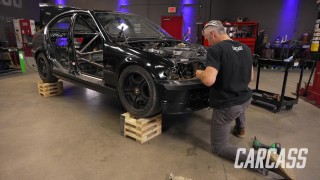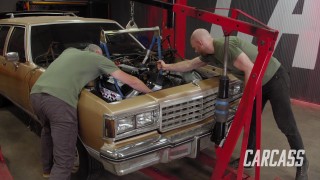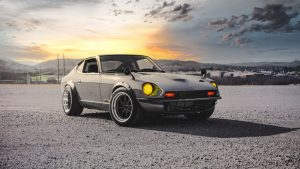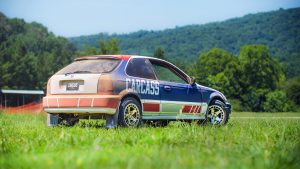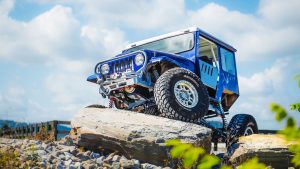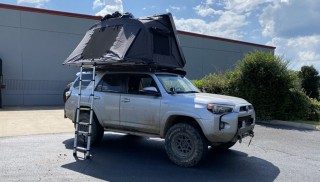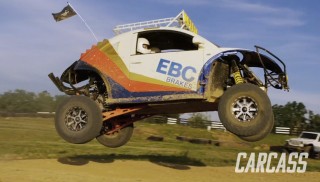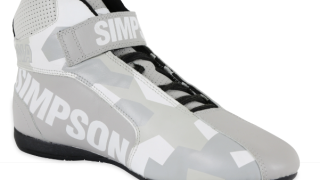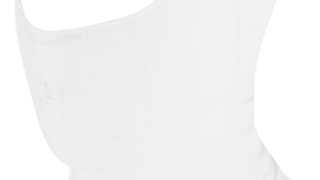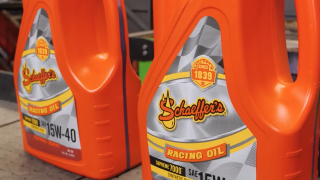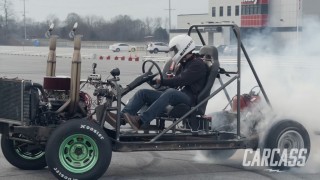Carcass Featured Projects
Carcass Builds
Want more content like this?
Join the PowerNation Email NewsletterEpisode Transcript
(Jimmy)>> You're watching Powernation!
(Jeremy)>> Today on Carcass our Camaro is torn apart so we can paint. Then we take the car back into the shop for reassembly and a custom wrap before taking it out and having a great day ripping it around on the track. [ Music ] [ engine revving ] [ Music ]
(Jeremy)>> What's up everybody, welcome to Carcass. All these parts and pieces you see laid out before you are exactly what it takes to build a race car. You're probably asking yourself, where did all these parts come from? Well they came off of our 1972 Road Course Camaro. You're probably also asking yourself why in the world did we tear this car completely down when it was almost done?
(Jimmy)>> The reason is we want to have this car finished and everything painted. So the easiest way to do that is to strip everything off the car, every single nut and bolt, and put it on this rotisserie so we can spin it around and make sure we don't miss a single spot. Then once it's done we can put it back together and we'll have a nice, finished product, but for now we've got to get this thing to the prep booth and start sanding. [ Music ]
(Jeremy)>> This thing's super long. The whole apparatus is super long. That should be good. [ Music ]
(Jimmy)>> The process of getting this thing prepped is just a combination of sanding and scuffing the different surfaces to get them ready for paint. On the roll cage and the tubing structures up front I just go over it with 180 grit sandpaper just to get through some of that mill scall. That'll give the surface some scratches, give the paint something to bite to so it sticks and remains durable for a long time.
(Jeremy)>> What I'm doing to prep the floor is we're using a drill with a wire wheel on it. Basically all we're trying to do here is use the wire wheel to clean up some of the areas and put sand scratches in the floor itself and everything else around the inside of the car. That way when we go to paint everything will stick. So then on the underside of the car we're gonna use the same process. We're gonna be using a drill and a wire wheel. We're also gonna be using the little grinder with the wire wheel on it. All we're basically doing here is trying to knock all of this old paint off, old undercoating off, or at least give us some really good scratches in all of that stuff. Just so the paint has something to stick to, and then if there is any bare metal surfaces, like the inside of the wheel tubs, we're gonna hit that with some 180 grit just to give that surface something to bite to when we go to paint it. Really the overall process here. This is a race car. So all we're trying to do is get something underneath here, get the paint to stick, and make it look good. Now that we have everything prepped the first place we're gonna start painting is inside here. So we've got to clean this all up. We'll wipe everything down, mix up some paint, and start shooting.
(Jimmy)>> Obviously there's a lot of tubing here I've got to wipe down. I would estimate close to 100 feet if not a little more than that. That's what you get when you spend 70 hours building a roll cage like this. A lot of prep work, whether you're building it or painting it. That's one thing people don't like doing is painting their own cages. If you want it to look good gotta put the time in.
(Jeremy)>> For the mask job that we're doing now is quick and dirty. What we're trying to do is make sure we don't get a bunch of overspray all over the car cause we don't want to go back and have to re-prep when the paint lays down. We're just trying to mask off the big areas. A little bit of overspray gets outside of those areas at least it lands on the paper and we don't have as much work to do. [ Music ]
[ spray gun hissing ]
(Jeremy)>> The biggest challenge with painting roll cages is all the different angles that you have to hit to make sure that you get good coverage on all the tubes. I'm really trying to pay attention to getting enough paint on the tubes to give it that shiny wet look but not hit the same spot so many times that it causes a run. Whatever spots I can't get to with the big gun we'll come back later and hit them with a touchup gun. We put the final touches on our paint. Then head back to the shop to put our Camaro back together for the final time.
[ spray gun hissing ]
(Jeremy)>> Welcome back! After we sprayed everything on the inside of the car with the white paint we went ahead, unmasked it all, remasked the entire car, and flipped it on its side. Now what Jimmy's doing is spraying the underside of the car with a chassis shield. All the paint that we're spraying came from Summit Racing. This will be great on some of the bare metal surfaces, but it'll also do really good coverage over the painted surfaces that were underneath. So he's kinda getting at it and we'll see how it turns out. [ spray gun hissing ] [ Music ]
[ fans humming ]
(Jeremy)>> With this stuff, if you're laying down two wet coats you're gonna give it about 30 minutes flash time, or dry time, in between each coat. Then you should be good to go. [ spray gun hissing ] [ Music ]
(Jeremy)>> Now that we have the car masked off we're gonna go ahead and spray the Summit Racing DTM, which is direct to metal epoxy primer mixed in a one-to-one ratio. Then we're just gonna spray the rest of the car with this to finish it off.
(Jimmy)>> Painting a car like this is great practice for me because I don't get to spend a whole lot of time behind the paint gun, and with the car like this knowing that it's going to be wrapped later it gives me a good opportunity to practice my spray patterns and make sure I'm laying down good coats.
(Jeremy)>> So especially in this instance where the car is gonna have a wrap over the top of it you don't have to be perfect with what you're doing. Jimmy's trying to do now is lay down a wet coat so it's basically smooth, and the wrap's just gonna go right over the top of this. So even if there's a little bit of debris or trash in the paint we can nip this out and the wrap will go down and look slick.
(Jimmy)>> We'll shoehorn it in here for the last time.
(Jeremy)>> Just as long as a guy knows how to drive this thing. Struggling right now.
(Jimmy)>> Go down a little bit. Stop, go forward.
(Jeremy)>> You mean backwards?
(Jimmy)>> Yes! Stay right there. [ Music ]
[ metal clanging ] [ Music ] [ metal clanging ]] [ Music ]
(Jeremy)>> Weasel this thing in here. Let's get this on here. Then we can finish up the car. [ Music ] Now that we have the Camaro pretty much buttoned up it's time to move on to some fluids. Since we pulled the car completely down to paint it, it's time to fill everything back up starting with this giant oil tank back here. We're gonna be running Shaeffer's High Performance Racing Oil. This is designed for high performance gasoline race engines just like the Motown LS we have underneath the hood. Now this is the same oil that we ran in the car on the chassis dyno, but since we had to pull the whole car down it's time to fill it up with some fresh stuff. Schaeffer's Supreme 7,000 Synthetic Plus oil has a superior film strength for extra protection against wear. It is proven performance against thermos breakdown, which will help us in our Camaro since it's going to be seeing a lot of heat cycles. Plus it's got friction modifiers. That will help provide a strong barrier against scuffing and abrasion. Pat and Frankie have this figured out. It's about 11 quarts in the tank here plus the extra stuff. Our lines are a little longer. We'll probably put about 11 or 12 in it. Should be good to go.
(Jimmy)>> One last thing I want to talk about as we've been putting our car together is heat management. We're using quite a few products from DEI to help keep our car in good working order. The first one being spark plug boots. We have our coil packs on the inside of the car. So our spark plug wires are very long, and they tend to be pretty floppy. So in the event that they are resting up against the header the spark plug boots are going to protect them. The next thing is the exhaust. The headers run very close to the floor. So we want to keep as much heat out of the driver compartment as possible, and we also have our brake and clutch master cylinders right by our feet as well. So what we did is we put some of their floor and tunnel shield, stuck it up to the bottom of the floor, and this is going to reflect a lot of the heat away from our feet and away from the brake and clutch master cylinders. The last thing is the fuel line runs right by the exhaust as well. So we have some of their heat shroud gold, and all of this stuff is gonna keep our car operating at a really high level.
(Jeremy)>> Coming up, we cover our Camaro with a race inspired wrap.
(Jimmy)>> Welcome back to the shop! We have our Camaro reassembled, and now we're about to see it make its biggest transformation.
(Jeremy)>> And that transformation comes in the form of a wrap. So we have Micah and Jimmy here from Graphic Effects, and they're gonna lay down a killer wrap on top of our Camaro. Now I'm a painter. So I know nothing about wrapping. Where do you guys get started? How do you do this?
(Micah)>> Usually start with the design. We've got y'alls design laid out. I think we've got it nailed down pretty good. Got some flat black, got some printed stuff. The only thing to do now is get sticking.
(Jimmy)>> You want to start with the matte black?
(Micah)>> Let's do some matte black and see where we go from there.
(Jeremy)>> Sounds good. [ Music ]
(Micah)>> When working with wraps you do have to be careful, and it does take some thought behind it. You can't just close your eyes and throw it on there and it magically appears. There is a lot of technique to it. It's very situational. It depends on the temperature. It could be hot outside but it's cloudy, and it acts one way, but if it's hot outside and the sun is out there too then it's gonna act completely different. If you're inside and it's 40 degrees a lot of times the vinyl becomes brittle. It can tear. So it's very temperature sensitive, and then it just depends on what you're putting it on. Are you putting it on a clean car? A nice smooth paint? You do a block wall and it doesn't just stick to a block wall. You actually have to torch every inch of it. There's techniques to do what you need to do, and certain situations require different techniques. The vinyl will tell you what it wants you've just got to know how to read it and you've got to know what to do when you see it. It's kinda crazy. Obviously if it's a race car it's gonna see a lot of potential damage. Even if it's just from debris, rocks, sand. Anything from being rubber coming off the racetrack. A lot of times you can clean it easily, and then if it does get messed up beyond repair then you can replace that whole panel with either just a piece of material or a click of the button and print out a new fender. You don't' necessarily have to repaint the whole car or reprint and rewrap the whole car. [ Music ]
(Jimmy)>> Our Camaro has made a huge transformation, and we want to give a big thank you to Micah and Jimmy for doing this. This thing has completely exceeded our expectations and looks a hundred times better than what we thought it could.
(Micah)>> This thing turned out great. It's really cool seeing the rendering, and seeing the design, and when it comes to life it's awesome! Thank y'all for letting us do it. It's a great opportunity, and in the future let us know if we can help you with anything else.
(Jimmy)>> Absolutely! Alright, a couple more things to do and then we can hit the track.
(Jeremy)>> Sounds good! Just amazing, this thing is just amazing!
(Jimmy)>> Along with the safety features on our Camaro we wanted to make sure that we stay safe as well. So we hooked up with Simpson and Holley Performance, and they gave us all of this personal safety gear when we're out on the track. Everything from shoes, socks, head sock, gloves, racing suit, HANS device, and a helmet. Just in the worst case scenario it's better to be safe than sorry. This is Simpson's Checker Suit, which is SFI-5 rated, has satin twill Nomex knit fabric, and all of these products also have SFI ratings to give us that fire protection just in case something happens and we do have a car fire. We're also really excited about this HANS device, which for those of you that don't know is a head and neck restraint system. In the case that we get into an impact it prevents our head from doing that dangerous whiplash motion. We are really pumped to use this stuff when we're out ripping on track in our Camaro, and we know that it's gonna keep us safe. [ engine revving ]
(Jimmy)>> Stick around, we're at the track and having a blast tearing up the pavement in our Road Course Camaro.
[ birds chirping ]
[ birds chirping ]
[ engine starting ] [ engine rumbling ]
[ engine idling ]
[ engine idling ]
[ engine revving ]
[ engine revving ]
[ engine revving ]
[ engine revving ]
(Jimmy)>> Alright everybody, today is the day that we finally get to payoff our Camaro. This is one of those projects, as many of you may know. You work on it for a really long time, and you have ups and downs, and you're trying to figure out if it's all worth it. If you should keep sinking money into, and if it's worth your time to do it. I can tell you ripping this thing for the first time down the straightaway it definitely makes it all worth it cause this thing is fast, it's mean, it hugs the turns, and it does exactly what we want it to do. [ engine revving ] [ Music ]
(Jimmy)>> We're out here at Polecat Training Center in Fayetteville, Tennessee, to put our car to the test. This track is 2.1-miles long and has about 120 feet of elevation change. It's a nice technical course that's really gonna test our car and our skill set. So let's see what this thing can do. [ engine revving ]
(Jimmy)>> My first impression of this car is it's really fast. Definitely faster than anything I've driven. I'm used to driving a pickup truck on the autocross course. So this is quite a different animal for me. This thing feels quite a bit more planted with the slicks on it. Of course a pickup truck is really light in the rear end too. So this car feels really well balanced with the UMI suspension under it. I think one of my favorite parts about this so far is shifting. Of course we have the dog box transmission that came out of a Nascar Cup car and learning how to shift up and down. We don't have to heel-toe. We can just flip the throttle as we're going through neutral. It makes for a really quick shift and makes for a really fun driving experience. It's really impressive the throttle response that this car has. This is the most horsepower I've ever had under my right foot. It's almost kinda scary, especially coming down that hill the way it pushes you back in the seat because you gain speed faster than your brain can really react. So huge kudos to the Engine Power guys putting together this Motown LS cause this thing absolutely rips. [ engine revving ]
(Jimmy)>> So we're coming on the back stretch here. Really open it up and see what it can do. [ engine revving ]
(Jeremy)>> Well you looked really fast. How was it?
(Jimmy)>> The fastest car we've ever built, and it's gonna put the biggest smile on your face. So you get in and you drive now.
(Jeremy)>> I will gladly get in and drive the car. I'm a little scared but I think I should be able to pull this off. [ Music ] [ engine revving ] [ Music ]
(Jeremy)>> We've had this car in our shop for a long time. We've done a ton of work to it, and we really did start with a good, solid platform. We didn't have to replace any of the floors or really worry about major damage on the car, but it was a really good platform for us to build something just like what we're driving right now. It took a long time for us to get to this point, but I couldn't ask for anything else. This car is an absolute animal. It's doing everything that we ask of it. We want to give a huge shout out to everyone over at EBC Brakes because as everybody knows a whole bunch of horsepower is no good if you can't stop it, especially in a car like this. So up to this point this has all been just a big dream for us. We wanted a car that could really perform and to be honest with you, a car that could scare me and this car is exactly that. With everything we've put into this car it is a little bit more than I can handle but it all works together really well. Watching Jimmy run this car around was amazing. For it to be in the hands of somebody that can really drive it just shows you everything we've done, how it's all been put together, and just how much fun you can really have on a racetrack with a race specific car. And really sitting in the seat right now running this thing around the track I am so happy with the way that it turned out. I just am grinning from ear to ear. It's so hard for me to focus on talking right now just because all I want to do is stab the throttle, hit those corners, and just have a good time out here.
Show Full Transcript
(Jeremy)>> Today on Carcass our Camaro is torn apart so we can paint. Then we take the car back into the shop for reassembly and a custom wrap before taking it out and having a great day ripping it around on the track. [ Music ] [ engine revving ] [ Music ]
(Jeremy)>> What's up everybody, welcome to Carcass. All these parts and pieces you see laid out before you are exactly what it takes to build a race car. You're probably asking yourself, where did all these parts come from? Well they came off of our 1972 Road Course Camaro. You're probably also asking yourself why in the world did we tear this car completely down when it was almost done?
(Jimmy)>> The reason is we want to have this car finished and everything painted. So the easiest way to do that is to strip everything off the car, every single nut and bolt, and put it on this rotisserie so we can spin it around and make sure we don't miss a single spot. Then once it's done we can put it back together and we'll have a nice, finished product, but for now we've got to get this thing to the prep booth and start sanding. [ Music ]
(Jeremy)>> This thing's super long. The whole apparatus is super long. That should be good. [ Music ]
(Jimmy)>> The process of getting this thing prepped is just a combination of sanding and scuffing the different surfaces to get them ready for paint. On the roll cage and the tubing structures up front I just go over it with 180 grit sandpaper just to get through some of that mill scall. That'll give the surface some scratches, give the paint something to bite to so it sticks and remains durable for a long time.
(Jeremy)>> What I'm doing to prep the floor is we're using a drill with a wire wheel on it. Basically all we're trying to do here is use the wire wheel to clean up some of the areas and put sand scratches in the floor itself and everything else around the inside of the car. That way when we go to paint everything will stick. So then on the underside of the car we're gonna use the same process. We're gonna be using a drill and a wire wheel. We're also gonna be using the little grinder with the wire wheel on it. All we're basically doing here is trying to knock all of this old paint off, old undercoating off, or at least give us some really good scratches in all of that stuff. Just so the paint has something to stick to, and then if there is any bare metal surfaces, like the inside of the wheel tubs, we're gonna hit that with some 180 grit just to give that surface something to bite to when we go to paint it. Really the overall process here. This is a race car. So all we're trying to do is get something underneath here, get the paint to stick, and make it look good. Now that we have everything prepped the first place we're gonna start painting is inside here. So we've got to clean this all up. We'll wipe everything down, mix up some paint, and start shooting.
(Jimmy)>> Obviously there's a lot of tubing here I've got to wipe down. I would estimate close to 100 feet if not a little more than that. That's what you get when you spend 70 hours building a roll cage like this. A lot of prep work, whether you're building it or painting it. That's one thing people don't like doing is painting their own cages. If you want it to look good gotta put the time in.
(Jeremy)>> For the mask job that we're doing now is quick and dirty. What we're trying to do is make sure we don't get a bunch of overspray all over the car cause we don't want to go back and have to re-prep when the paint lays down. We're just trying to mask off the big areas. A little bit of overspray gets outside of those areas at least it lands on the paper and we don't have as much work to do. [ Music ]
[ spray gun hissing ]
(Jeremy)>> The biggest challenge with painting roll cages is all the different angles that you have to hit to make sure that you get good coverage on all the tubes. I'm really trying to pay attention to getting enough paint on the tubes to give it that shiny wet look but not hit the same spot so many times that it causes a run. Whatever spots I can't get to with the big gun we'll come back later and hit them with a touchup gun. We put the final touches on our paint. Then head back to the shop to put our Camaro back together for the final time.
[ spray gun hissing ]
(Jeremy)>> Welcome back! After we sprayed everything on the inside of the car with the white paint we went ahead, unmasked it all, remasked the entire car, and flipped it on its side. Now what Jimmy's doing is spraying the underside of the car with a chassis shield. All the paint that we're spraying came from Summit Racing. This will be great on some of the bare metal surfaces, but it'll also do really good coverage over the painted surfaces that were underneath. So he's kinda getting at it and we'll see how it turns out. [ spray gun hissing ] [ Music ]
[ fans humming ]
(Jeremy)>> With this stuff, if you're laying down two wet coats you're gonna give it about 30 minutes flash time, or dry time, in between each coat. Then you should be good to go. [ spray gun hissing ] [ Music ]
(Jeremy)>> Now that we have the car masked off we're gonna go ahead and spray the Summit Racing DTM, which is direct to metal epoxy primer mixed in a one-to-one ratio. Then we're just gonna spray the rest of the car with this to finish it off.
(Jimmy)>> Painting a car like this is great practice for me because I don't get to spend a whole lot of time behind the paint gun, and with the car like this knowing that it's going to be wrapped later it gives me a good opportunity to practice my spray patterns and make sure I'm laying down good coats.
(Jeremy)>> So especially in this instance where the car is gonna have a wrap over the top of it you don't have to be perfect with what you're doing. Jimmy's trying to do now is lay down a wet coat so it's basically smooth, and the wrap's just gonna go right over the top of this. So even if there's a little bit of debris or trash in the paint we can nip this out and the wrap will go down and look slick.
(Jimmy)>> We'll shoehorn it in here for the last time.
(Jeremy)>> Just as long as a guy knows how to drive this thing. Struggling right now.
(Jimmy)>> Go down a little bit. Stop, go forward.
(Jeremy)>> You mean backwards?
(Jimmy)>> Yes! Stay right there. [ Music ]
[ metal clanging ] [ Music ] [ metal clanging ]] [ Music ]
(Jeremy)>> Weasel this thing in here. Let's get this on here. Then we can finish up the car. [ Music ] Now that we have the Camaro pretty much buttoned up it's time to move on to some fluids. Since we pulled the car completely down to paint it, it's time to fill everything back up starting with this giant oil tank back here. We're gonna be running Shaeffer's High Performance Racing Oil. This is designed for high performance gasoline race engines just like the Motown LS we have underneath the hood. Now this is the same oil that we ran in the car on the chassis dyno, but since we had to pull the whole car down it's time to fill it up with some fresh stuff. Schaeffer's Supreme 7,000 Synthetic Plus oil has a superior film strength for extra protection against wear. It is proven performance against thermos breakdown, which will help us in our Camaro since it's going to be seeing a lot of heat cycles. Plus it's got friction modifiers. That will help provide a strong barrier against scuffing and abrasion. Pat and Frankie have this figured out. It's about 11 quarts in the tank here plus the extra stuff. Our lines are a little longer. We'll probably put about 11 or 12 in it. Should be good to go.
(Jimmy)>> One last thing I want to talk about as we've been putting our car together is heat management. We're using quite a few products from DEI to help keep our car in good working order. The first one being spark plug boots. We have our coil packs on the inside of the car. So our spark plug wires are very long, and they tend to be pretty floppy. So in the event that they are resting up against the header the spark plug boots are going to protect them. The next thing is the exhaust. The headers run very close to the floor. So we want to keep as much heat out of the driver compartment as possible, and we also have our brake and clutch master cylinders right by our feet as well. So what we did is we put some of their floor and tunnel shield, stuck it up to the bottom of the floor, and this is going to reflect a lot of the heat away from our feet and away from the brake and clutch master cylinders. The last thing is the fuel line runs right by the exhaust as well. So we have some of their heat shroud gold, and all of this stuff is gonna keep our car operating at a really high level.
(Jeremy)>> Coming up, we cover our Camaro with a race inspired wrap.
(Jimmy)>> Welcome back to the shop! We have our Camaro reassembled, and now we're about to see it make its biggest transformation.
(Jeremy)>> And that transformation comes in the form of a wrap. So we have Micah and Jimmy here from Graphic Effects, and they're gonna lay down a killer wrap on top of our Camaro. Now I'm a painter. So I know nothing about wrapping. Where do you guys get started? How do you do this?
(Micah)>> Usually start with the design. We've got y'alls design laid out. I think we've got it nailed down pretty good. Got some flat black, got some printed stuff. The only thing to do now is get sticking.
(Jimmy)>> You want to start with the matte black?
(Micah)>> Let's do some matte black and see where we go from there.
(Jeremy)>> Sounds good. [ Music ]
(Micah)>> When working with wraps you do have to be careful, and it does take some thought behind it. You can't just close your eyes and throw it on there and it magically appears. There is a lot of technique to it. It's very situational. It depends on the temperature. It could be hot outside but it's cloudy, and it acts one way, but if it's hot outside and the sun is out there too then it's gonna act completely different. If you're inside and it's 40 degrees a lot of times the vinyl becomes brittle. It can tear. So it's very temperature sensitive, and then it just depends on what you're putting it on. Are you putting it on a clean car? A nice smooth paint? You do a block wall and it doesn't just stick to a block wall. You actually have to torch every inch of it. There's techniques to do what you need to do, and certain situations require different techniques. The vinyl will tell you what it wants you've just got to know how to read it and you've got to know what to do when you see it. It's kinda crazy. Obviously if it's a race car it's gonna see a lot of potential damage. Even if it's just from debris, rocks, sand. Anything from being rubber coming off the racetrack. A lot of times you can clean it easily, and then if it does get messed up beyond repair then you can replace that whole panel with either just a piece of material or a click of the button and print out a new fender. You don't' necessarily have to repaint the whole car or reprint and rewrap the whole car. [ Music ]
(Jimmy)>> Our Camaro has made a huge transformation, and we want to give a big thank you to Micah and Jimmy for doing this. This thing has completely exceeded our expectations and looks a hundred times better than what we thought it could.
(Micah)>> This thing turned out great. It's really cool seeing the rendering, and seeing the design, and when it comes to life it's awesome! Thank y'all for letting us do it. It's a great opportunity, and in the future let us know if we can help you with anything else.
(Jimmy)>> Absolutely! Alright, a couple more things to do and then we can hit the track.
(Jeremy)>> Sounds good! Just amazing, this thing is just amazing!
(Jimmy)>> Along with the safety features on our Camaro we wanted to make sure that we stay safe as well. So we hooked up with Simpson and Holley Performance, and they gave us all of this personal safety gear when we're out on the track. Everything from shoes, socks, head sock, gloves, racing suit, HANS device, and a helmet. Just in the worst case scenario it's better to be safe than sorry. This is Simpson's Checker Suit, which is SFI-5 rated, has satin twill Nomex knit fabric, and all of these products also have SFI ratings to give us that fire protection just in case something happens and we do have a car fire. We're also really excited about this HANS device, which for those of you that don't know is a head and neck restraint system. In the case that we get into an impact it prevents our head from doing that dangerous whiplash motion. We are really pumped to use this stuff when we're out ripping on track in our Camaro, and we know that it's gonna keep us safe. [ engine revving ]
(Jimmy)>> Stick around, we're at the track and having a blast tearing up the pavement in our Road Course Camaro.
[ birds chirping ]
[ birds chirping ]
[ engine starting ] [ engine rumbling ]
[ engine idling ]
[ engine idling ]
[ engine revving ]
[ engine revving ]
[ engine revving ]
[ engine revving ]
(Jimmy)>> Alright everybody, today is the day that we finally get to payoff our Camaro. This is one of those projects, as many of you may know. You work on it for a really long time, and you have ups and downs, and you're trying to figure out if it's all worth it. If you should keep sinking money into, and if it's worth your time to do it. I can tell you ripping this thing for the first time down the straightaway it definitely makes it all worth it cause this thing is fast, it's mean, it hugs the turns, and it does exactly what we want it to do. [ engine revving ] [ Music ]
(Jimmy)>> We're out here at Polecat Training Center in Fayetteville, Tennessee, to put our car to the test. This track is 2.1-miles long and has about 120 feet of elevation change. It's a nice technical course that's really gonna test our car and our skill set. So let's see what this thing can do. [ engine revving ]
(Jimmy)>> My first impression of this car is it's really fast. Definitely faster than anything I've driven. I'm used to driving a pickup truck on the autocross course. So this is quite a different animal for me. This thing feels quite a bit more planted with the slicks on it. Of course a pickup truck is really light in the rear end too. So this car feels really well balanced with the UMI suspension under it. I think one of my favorite parts about this so far is shifting. Of course we have the dog box transmission that came out of a Nascar Cup car and learning how to shift up and down. We don't have to heel-toe. We can just flip the throttle as we're going through neutral. It makes for a really quick shift and makes for a really fun driving experience. It's really impressive the throttle response that this car has. This is the most horsepower I've ever had under my right foot. It's almost kinda scary, especially coming down that hill the way it pushes you back in the seat because you gain speed faster than your brain can really react. So huge kudos to the Engine Power guys putting together this Motown LS cause this thing absolutely rips. [ engine revving ]
(Jimmy)>> So we're coming on the back stretch here. Really open it up and see what it can do. [ engine revving ]
(Jeremy)>> Well you looked really fast. How was it?
(Jimmy)>> The fastest car we've ever built, and it's gonna put the biggest smile on your face. So you get in and you drive now.
(Jeremy)>> I will gladly get in and drive the car. I'm a little scared but I think I should be able to pull this off. [ Music ] [ engine revving ] [ Music ]
(Jeremy)>> We've had this car in our shop for a long time. We've done a ton of work to it, and we really did start with a good, solid platform. We didn't have to replace any of the floors or really worry about major damage on the car, but it was a really good platform for us to build something just like what we're driving right now. It took a long time for us to get to this point, but I couldn't ask for anything else. This car is an absolute animal. It's doing everything that we ask of it. We want to give a huge shout out to everyone over at EBC Brakes because as everybody knows a whole bunch of horsepower is no good if you can't stop it, especially in a car like this. So up to this point this has all been just a big dream for us. We wanted a car that could really perform and to be honest with you, a car that could scare me and this car is exactly that. With everything we've put into this car it is a little bit more than I can handle but it all works together really well. Watching Jimmy run this car around was amazing. For it to be in the hands of somebody that can really drive it just shows you everything we've done, how it's all been put together, and just how much fun you can really have on a racetrack with a race specific car. And really sitting in the seat right now running this thing around the track I am so happy with the way that it turned out. I just am grinning from ear to ear. It's so hard for me to focus on talking right now just because all I want to do is stab the throttle, hit those corners, and just have a good time out here.







